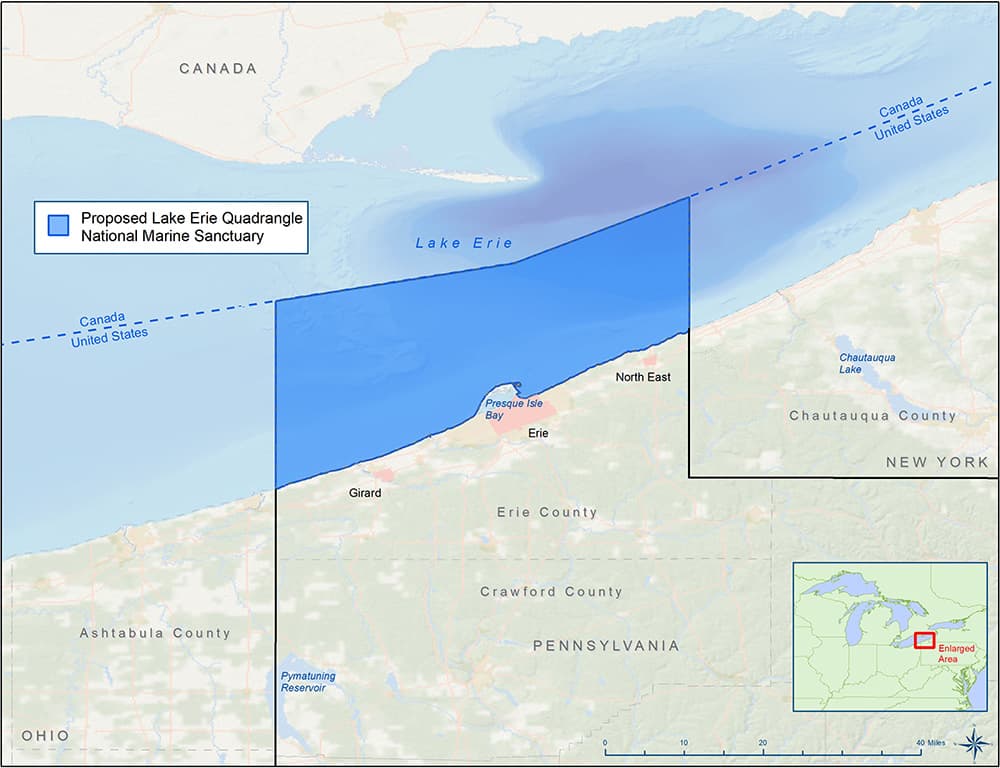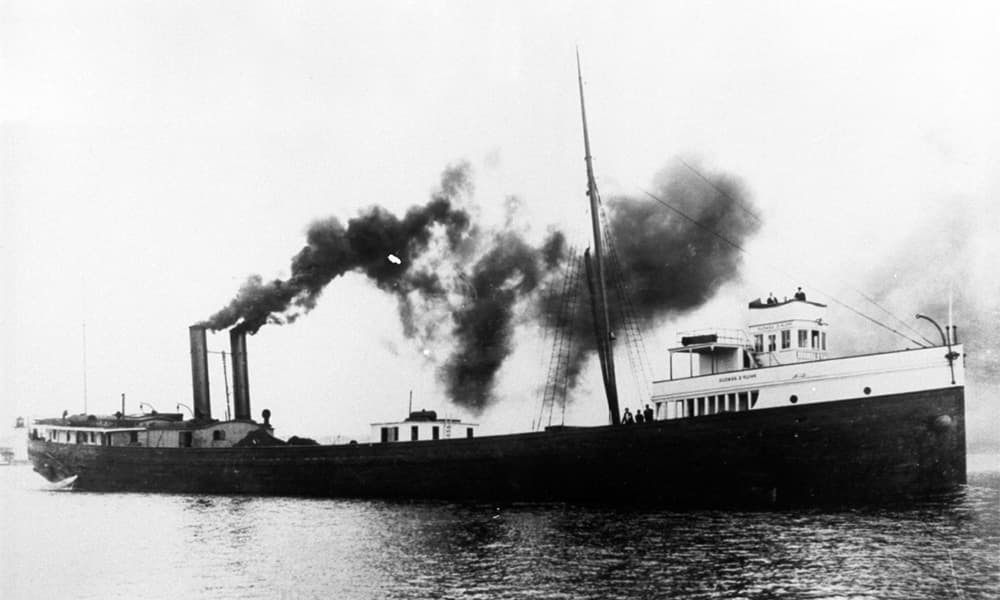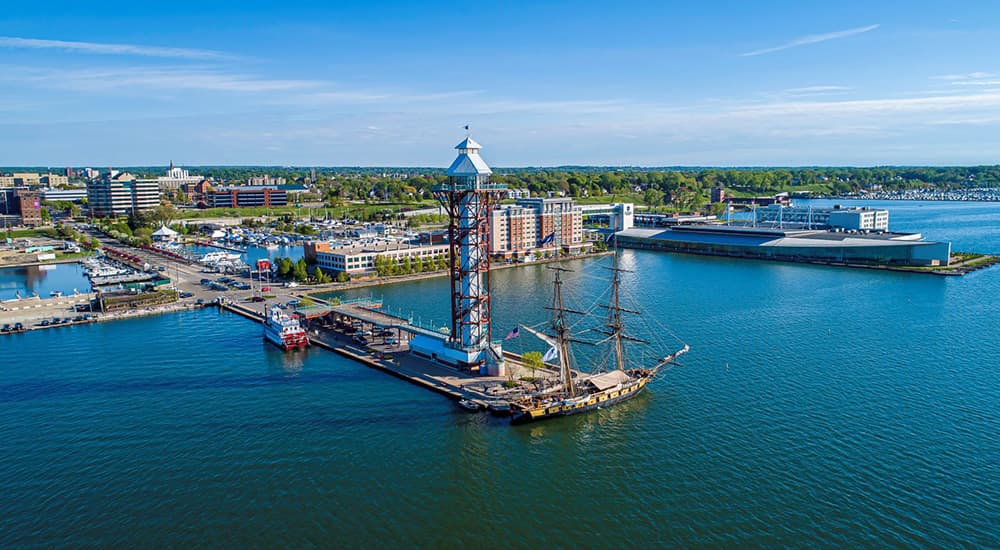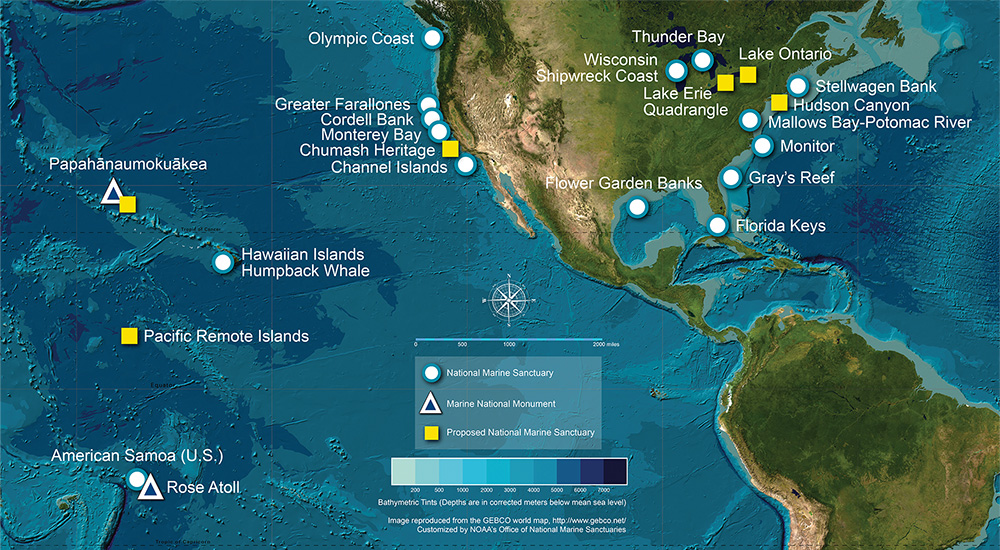NOAA's Office of National Marine Sanctuaries is in the early stages of the process to designate a new national marine sanctuary in Lake Erie, adjacent to Pennsylvania. A sanctuary in the Pennsylvania portion of Lake Erie would enable NOAA to protect the region's maritime heritage resources, including a nationally significant collection of shipwrecks. NOAA started the sanctuary designation process in June 2023.
About the Area Under Consideration
The proposed Lake Erie National Marine Sanctuary would encompass approximately 740 square miles of Pennsylvania's Lake Erie waters, from the shoreline to the Canadian border. The approximately 75 miles of proposed sanctuary shoreline along Erie County contain six townships, two boroughs, and the city of Erie. The nomination proposes to exclude the Port of Erie from the sanctuary boundaries to ensure compatible use with shipping and other commercial activities.

This area represents a historically and culturally rich region where the long relationship between human activity and the maritime environment has created meaning and a sense of place, which is expressed and preserved in a wide variety of maritime cultural resources, from sacred places and cultural practices, to lighthouses and historic shipwrecks. Together, these tangible and intangible elements form a rich maritime cultural landscape. Lake Erie hosted one of the busiest inland waterways of the mid-19th century. Pennsylvania supported the Great Lakes' largest commercial fishing fleet during the 19th century, some of the earliest shipbuilding on the Great Lakes, and major naval shipyards during the War of 1812.

Nearly every type of vessel that operated on the Great Lakes during the 19th and 20th centuries is represented in the area being considered for sanctuary designation. Based on historical records, 196 vessels may have sunk within the Pennsylvania waters of Lake Erie, and 35 of these shipwrecks have been identified. The known shipwrecks span from the 1838 steamboat Chesapeake to speedboats, tugs, barges, and workboats lost before 1940. The collection includes schooners, brigs, and barks; barges and schooner barges; dredges and sand suckers; fishing tugs and trawlers; and sidewheel steamboats and propellers. This area also includes the potential for submerged prehistoric sites and historic properties that may be of religious and cultural significance to Indigenous nations and tribes.

If designated, NOAA's activities would complement the Commonwealth of Pennsylvania's efforts to preserve and interpret the area's importance, including its collection of nationally significant historic shipwrecks and other underwater cultural resources. With this designation, NOAA could:
- Use its research and monitoring assets to further locate, document, and monitor the area's significant cultural resources.
- Provide a national stage for promoting heritage tourism and recreation, which has the potential to increase economic opportunities in local coastal communities.
- Expand education and outreach activities to build public knowledge of and appreciation for Great Lakes maritime cultural heritage and ties to past and present uses.
- Prevent damage to irreplaceable historical sites by promoting the responsible use of sanctuary resources.

The Designation Process
NOAA initiated the sanctuary designation process for the proposed National Marine Sanctuary in Lake Erie on May 19, 2023, when it published a notice of intent to begin the process and solicited public comment. NOAA received almost 200 comments during the public comment period, May 19 to July 18, 2023. The Lake Erie team is using the comments NOAA received to develop a proposed sanctuary management plan, draft environmental impact statement, proposed rule and proposed sanctuary boundaries. NOAA will publish the draft designation documents, including a public comment period, and will consider public input before making a final decision.
Public Scoping
May - July 2023
- In-person public meeting held June 21, 2023
- Virtual public meetings held June 27, 2023 and June 28, 2023
- Electronic public comments submitted through the Federal eRulemaking Portal, www.regulations.gov, to docket number NOAA-NOS-2023-0039.
- Written public comments mailed to NOAA Sanctuaries Eastern Regional Office.
Current Step
Review of Public Comments and Preparation of Draft Documents
ONMS staff review all public comments submitted during the scoping period and produce a draft management plan, draft environmental impact statement, proposed regulations and proposed boundaries.
Release Draft Designation Documents and Provide for Public Comment Period
NOAA solicits public review and comment on the draft designation documents.
Prepare Final Designation Documents
NOAA will again consider all public comments received on the draft designation documents before finalizing the sanctuary's designation and producing final designation documents.
Publish Final Designation Documents
Sanctuary Designation
NOAA's National Marine Sanctuary System
Safeguarding America's Premier Marine Places
From Washington state to the Gulf of America and from the Great Lakes to the Pacific Islands, the National Marine Sanctuary System protects 18 underwater parks spanning over 629,000 square miles of ocean and Great Lakes waters. By investing in innovative solutions, we strengthen these iconic places to address 21st-century challenges while supporting America's commerce and tourism. These unique locations inspire people to visit, value, and steward our nation’s iconic ocean and Great Lakes waters.
Through the National Marine Sanctuaries Act, NOAA can identify, designate, and protect areas of the marine and Great Lakes environment that have special national significance.


